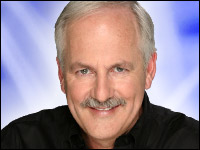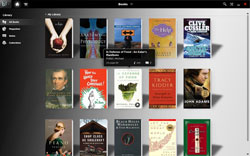
Last week, I spoke about how CES was back, and I gave some of the highlights. However, there always are discussions and trends going on behind the scenes, almost-invisible products, and impressions that take a while to form that can be even more interesting.
There was one keynote that came close to being the worst I’ve ever seen; Panasonic kicked a little Sony butt, and a couple of little companies looked like they may be on the verge of becoming really big. I’ll explore those today.
I’ll close with my product of the week: Blio, which anticipates the iSlate and the coming 3rd-generation e-book readers.
Ford: How Not to Do a Keynote in Four Easy Steps
There was one keynote at CES that would have me almost swear off ever going to a keynote again. Had I been handcuffed to a chair in the room, I would have been tempted to chew my arm off and drag myself out the door. It was by Ford.
I love cars; in fact, I just picked up a used FX35 and had it supercharged (link showcases the project) so I could go out and intimidate Porsche Cayenne owners (no one ever said I was nice). I was really looking forward to hearing how the one U.S. car company that was doing well was going to get me excited about the gadgets in its vastly improved Taurus or hot Mustangs. Instead, I saw a PowerPoint slide show by several folks that was long on words and short on, oh I don’t know, CARS.
You have to work to make cars boring, but damn if Ford didn’t pull it off. I’d been at an Audi event with self-drive cars at Stamford a few weeks earlier, and it had a video of a robotic TT (we have a TT) that was going to try to race up Pikes Peak. The video is worth watching. I’d thought we might see something equally advanced from Ford, and boy was I disappointed.
CES is a toy show, and the car section is a place where guys can go and see great cars. The cool car at the show was a stealth black Lexus that made the Fords in the area look like someone missed a meeting. Ford can do better; it really wouldn’t have been hard.
Plug Computers Taking Over the World
I was on a panel with Guy Kawasaki (Thanks to Jason Hiner I outranked Guy for People to follow on Twitter, not that I’d rub that in — probably the only time I’ll beat him in anything) talking about Marvell’s plug computing initiative. Guy is classic Apple-trained and can see the magic in products others might otherwise miss.
We started chatting about how this little single task plug-in computer could transform computing by connecting dynamically with peers to form ever more-powerful virtual constructs. Kind of like building a super computer one little processor at a time and being able to use the unused processing power of your neighbors or even people located half way around the globe.
This was probably one of the more revolutionary concepts with unknown and nearly unlimited potential. It was fun chatting with Guy — and yes, he still is a huge Apple fan.
Spreezio: Price Club for Everything Else
I ran into an interesting idea at CES in terms of a mobile location-based application. Companies like Microsoft and Google are in a constant hunt for things like this, and speculation in Silicon Valley continues to run high on which company will get gobbled up next.
Spreezio, which is in beta at the moment, is based on a fascinating concept: Folks are invited to bid on your business and create virtual discount coupons. Let’s say you’re in the mood for Mexican food. You would launch the application, specify the kind of discount you’d like, and go to a place that offers it.
Granted, you may want to be a little careful — if someone is giving, say, a 75 percent discount, I’m not sure I’d want to eat the food.
This model could also be used to create discount coupons for consumer electronics and other packaged goods. The idea is an interesting one; we’ll see how well it works when the service goes gold in the spring.
Making 3-D Work
The show was awash with 3-D TVs. I had to do a workup for one of the networks on this to test some of the incredibly high projections being put out there by other analysts. To do this, I had to go back and look at the rollout for color TV, and I found it took 14 years — and the launch of “Walt Disney’s Wonderful World of Color” — to get color TVs off the ground. 3-D not only lacks a show like Disney’s but requires active shutter glasses that can cost between US$40 and $100 a pair, and you can’t use them for anything else. Can you picture the cost of having a Super Bowl party? (Sports look wonderful in 3-D.)
There was a little two-man company at CES that was onto something called “MacroVision Optical 3-D.” It offers a line of polarized 3-D glasses, the kind you use in theaters, that are also attractive dark glasses. Not being a fan of looking too geeky in theaters, I had to order a pair. If someone can do this with active shutter glasses, then maybe we can get this 3-D puppy off the ground. By the way, of the major vendors, Panasonic has the best looking 3-D glasses.
Panasonic Trumps Sony
CES has always been kind of a Sony show, but Sony isn’t the firm it once was. Every year, there is at least one Sony product that is worth seeing. This year, it showed 3-D OLED, and folks didn’t seem to care. Panasonic actually had a stronger presence this year, but what made it stand out was it was one of the few that embraced the show’s green theme. It showcased not only the typical stunning CE gear, but also a hybrid solar fuel-cell home solution that could cut your power bill — and, more importantly, dramatically reduce your carbon footprint.
I agree with Earth 911: Panasonic was the “Most Standout Company at CES” (link has pictures of the fuel cell/solar prototype). So many of these wonderful new devices are taking a toll on our environment, because they increase our carbon footprint. By aggressively moving to offer products that directly address that, and by having a booth that attracted most of the major media outlets, I think Panasonic this year took CES from Sony as the CE vendor of the show.
Product of the Week: Blio 3rd-Generation E-Book Platform

The first generation of e-book readers has been around for a while, and it is defined by readers who just showcase text, with the Kindle being the best of the bunch.
The second generation of e-book readers is defined by the Hearst Skiff and Plastic Logic Que, and they will offer advanced page layouts like magazines and newspapers. (I don’t expect the 2nd generation to be around long.)
The 3rd generation will be defined by devices like the iSlate (Apple’s rumored new product) and displays like the Qualcomm Mirasol display, which will support color and multimedia, and create books that exceed anything we have ever seen on paper.
In short, the 1st- and 2nd-generation products close the gap with paper, and the 3rd generation blows paper books away, because it allows illustrations and pictures to move and become interactive. It also allows for the blending of technology. For instance, you could start reading a book, see scenes from the movie or TV show made from the book, and have the book read to you by the author — all in sync.
Ray Kurzweil, who created optical character recognition, among other things, created the Blio platform that enables these 3rd-generation readers. It is an amazing thing to create a product well ahead of the market, and Blio, which initially runs on your PC, is such an offering. It will now wait for the hardware to catch up, but the rumored iSlate from Apple should be capable of handling this.
Blio is an amazing, forward-looking e-book service that creates a foundation for the 3rd-generation e-book, and that makes it a natural for my product of the week.
Rob Enderle is a TechNewsWorld columnist and the principal analyst for the Enderle Group, a consultancy that focuses on personal technology products and trends.












































